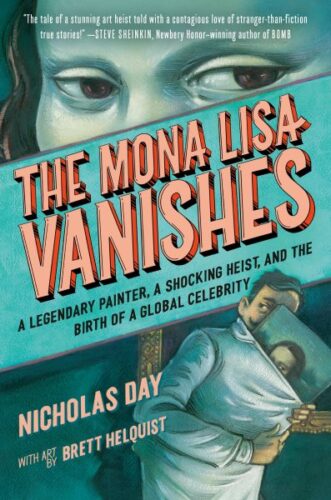Review of the Day: The Mona Lisa Vanishes by Nicholas Day, ill. Brett Helquist

The Mona Lisa Vanishes: A Legendary Painter, a Shocking Heist, and the Birth of a Global Celebrity
By Nicholas Day
Illustrated by Brett Helquist
Random House Studio (and imprint of Random House Children’s Books)
$22.99
ISBN: 9780593643846
Ages 9-12
On shelves September 5th
I sense that we are on the brink of something. I’ve sensed it for a while. Do you remember when Smile by Raina Telgemeier came out and all of a sudden the demand for graphic novels and comics for kids reached a fever pitch? Do you also remember that it took another decade before the publishing world could catch up and start to seriously meet demand? Well, this isn’t the same thing, but in terms of timing the Smile saga may provide a bit of a blueprint. Thanks to the work of such writers as Steve Sheinkin, Deborah Heiligman, and more, we are beginning to enter into a new era of informational texts for older kids. I mean, for years schools have been ramming dull nonfiction down the throats of students without cease. It was just a matter of time before authors started creating books that were, I dunno, actually interesting to kids as well. Still, I’ve a sense that nonfiction can be a hard sell to some publishers. But maybe that’s because it’s the gatekeepers avoiding them rather than the kids. I’ll tell you right now that if you handed a kid above the ages of nine or ten a copy of The Mona Lisa Vanishes and told them to read it, they would devour it in mere hours. It has everything! An art heist! Celebrity! Picasso being THE WORST (he really is)! And an indictment of our perpetual fascination with conspiracy theories based on our skewed assumptions and prejudices! It is the MOST enjoyable book you’re likely to read in a very long while. The start of something big?
ADVERTISEMENT
ADVERTISEMENT
It happened on a Monday. Monday, August 21, 1911, to be precise. A man in a white coat walked over to the Mona Lisa, a relatively obscure painting at the time. He deftly removed it from the wall, took it from its frame, and after some mild difficulties with a door, left the Louvre itself. What followed were events that would turn the painting from a lesser-known Leonardo da Vinci into the most famous woman in the world. But to understand how this event even came to happen, we must also travel back to the age of da Vinci and meet the man himself. Because when you get right down to it, the very creation of this piece of art was, in and of itself, a near miracle. Deftly bouncing between the early 16th century and the early 20th, Nicholas Day weaves a proper mystery along with a possible explanation of what made the theft of the Mona Lisa so much more than just a painting gone awry.

In the June 26, 2023 issue of New Yorker, a piece called “Now You See It” by Kathryn Schulz discusses at length the art of the heist and asks, “Why, given our overall disapproval of theft, are stories about heists so appealing – to so many of us..?” The answer may lie in the definition of the word itself. She writes, “For the most part, ‘heist’ suggests less a specific illegal action than the form of entertainment that depicts it.” As such The Mona Lisa Vanishes is most certainly a variation on the heist genre, particularly in its play-by-play opening. But Schulz is also quick to mention that the art thief that exists in our mind, of stealing art for art’s sake, is essentially, “a figment of our collective imagination.” So he plays it both ways. He both indulges in the excitement of such a theft (heck, he opens the whole books with it) while, at the same time, makes it clear how desperately we readers want the answer to the mystery to be big and grand and impressive. But the gentleman art thief who also happens to be a genius is as fake as they come. Day examines that fact at length, never sacrificing the fun that comes with the speculation.
Not that this was the only art heist book for kids I’d ever encountered. Until “The Mona Lisa Vanishes” the only other book I’d read to cover this specific crime was the highly amusing, but fictional, Steal Back the Mona Lisa by Meghan McCarthy. Mind you Meghan did mention this actual theft in the backmatter, and for that we are grateful. Still and all, when I think of art theft books for kids, only a couple are out there. There’s Tricky Vic: The Impossibly True Story of the Man Who Sold the Eiffel Tower by Greg Pizzoli. And then there’s the book that Mona Lisa reminded me of the most: The 500 Million Dollar Heist by Tom Sullivan. I was particularly fond of that book when it came out, but beyond the crime itself, Day’s book is an entirely different beast. Day’s is irreverent and funny and less invested in allowing kid readers to try to solve the crime themselves.
Look, you can write a lovely book, but if you’re able to integrate a sense of humor into it then that, to my mind, elevates everything. Nicholas Day has a gift. He knows how to tell a joke. They vary, of course. On the broader side he might write chapter breaks with titles like, “A Couple of Wild and Crazy Guys: In Which Louis Lepine Finds an International Gang of Thieves and a Monkey.” That’s pretty good. Or, later on when he nears the end of the book, he might mention a key place in the story and then write, “The Hotel Tripoli-Italia no longer exists. It is now the Hotel La Gioconda.” Pause. “Tripadvisor ranks it #398 of 428 hotels in Florence.” Ow. Day is, quite simply, a remarkable writer. In one moment, long after the Mona Lisa theft but before she was found again, a man sent art dealer Alfredo Geri a letter saying he had the Mona Lisa. On a lark, Geri conferred with the director of the great Florence art museum, the Uffizi. That man was Giovanni Poggi and the book says of the man, “he would save the museum’s paintings from Nazi looting during World War II. But his obituaries would lead with what happened after Alfredo Geri visited him that November afternoon.” That’s how you do it, son.

But for me, the most impressive thing about this book, even more than the copious amounts of humor, the adept back and forthing between time periods, or even the delivery of the mystery itself, is the way in which Day is able to tie all these elements into his bigger theme. At one point, he writes that even after the true thief, Vincenzo Perugia, confessed to the crime and the Mona Lisa was recovered, the French authorities wanted to believe their criminal mastermind theory anyway. Knowing that the man they sought was just a housepainter didn’t make sense to them. And so Day writes, “The myth was more persuasive than the truth. It was a better story. People will choose the better story every time.” Later, Day tells the tale of reporter Karl Decker, who made up his own gentleman thieves and forgers for his “reporting” in America. After recounting his humbuggery Day says, “In the end, we’re all like the French authorities. We’re all suckers for a better story.” Don’t go looking down your nose at the people who want these stories to be true so much that they ignore the obvious warning signs. We’re no better. But maybe, with the help of books like Day’s, we can start teaching our kids how to be critical thinkers, and less prone to grifters.
“In a conspiracy theory, belief matters more than facts. Belief in a conspiracy inevitably leads you away from the facts. In the Mona Lisa theft, we can see this toxic way of thinking in action.” The story of the theft of the Mona Lisa could easily have remained just that. A fun little dip into the past with a couple of deviations along the way. Instead, Day’s got his arms wrapped around something a whole lot bigger than just AWOL wall décor. He’s speaking to the times in which we live, where conspiracies entice and ensnare with alacrity. As such, The Mona Lisa Vanishes both entertains and instructs. You get you heist fix, but you’re also going to get a 101 on being more like, well, Leonardo da Vinci. Be relentlessly curious. Observe first. Make your deductions based on facts, not assumptions. Because it seems to me that in this current day and age, we are more in need of books that instruct our kids to be critical thinkers than ever before. Even if it takes a missing Mona to do it.
On shelves September 5th.
Source: Galley sent from publisher for review.
Interviews: Nicholas Day discusses the creation of this book here.
Filed under: Best Books, Best Books of 2023, Reviews, Reviews 2023
About Betsy Bird
Betsy Bird is currently the Collection Development Manager of the Evanston Public Library system and a former Materials Specialist for New York Public Library. She has served on Newbery, written for Horn Book, and has done other lovely little things that she'd love to tell you about but that she's sure you'd find more interesting to hear of in person. Her opinions are her own and do not reflect those of EPL, SLJ, or any of the other acronyms you might be able to name. Follow her on Twitter: @fuseeight.
ADVERTISEMENT
ADVERTISEMENT
SLJ Blog Network
Name That LEGO Book Cover! (#53)
K is in Trouble | Review
Fighting Public School Book Bans with the Civil Rights Act
Take Five: Middle Grade Anthologies and Short Story Collections
ADVERTISEMENT







